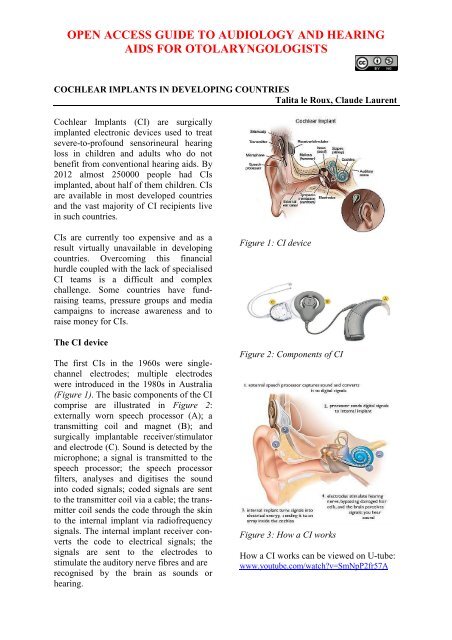Cochlear Implants in Developing Countries - Vula - University of ...
Cochlear Implants in Developing Countries - Vula - University of ...
Cochlear Implants in Developing Countries - Vula - University of ...
You also want an ePaper? Increase the reach of your titles
YUMPU automatically turns print PDFs into web optimized ePapers that Google loves.
acoustic <strong>in</strong>put <strong>in</strong>to a usable electricaldynamic range for each electrode which isstimulated.The audiologist who does the programm<strong>in</strong>g/MAPp<strong>in</strong>gis responsible for ma<strong>in</strong>tenanceand programm<strong>in</strong>g <strong>of</strong> the CI, <strong>in</strong>clud<strong>in</strong>g<strong>in</strong>itial stimulation and regular followupprogramm<strong>in</strong>g sessions. The audiologistobta<strong>in</strong>s 2 psychophysical measures i.e.elec-trical thresholds (T-levels) andcomfort levels (C-levels), to create aprogram (MAP).An appropriate encod<strong>in</strong>g strategy as wellas a stimulation mode should be selectedfor each patient. Encod<strong>in</strong>g strategy is themeans by which an implant translates the<strong>in</strong>com<strong>in</strong>g acoustic signal <strong>in</strong>to patterns <strong>of</strong>electrical pulses which <strong>in</strong> turn stimulate theauditory nerve fibres. Stimulation moderefers to the flow <strong>of</strong> electric current, that is,the location <strong>of</strong> the <strong>in</strong>different (reference)electrode relative to the active (stimulated)electrode. A comb<strong>in</strong>ation <strong>of</strong> objective andbehavioural programm<strong>in</strong>g techniques areutilised to establish an appropriate MAPfor each CI recipient.Bilateral CIsIn the developed world, children andgrow<strong>in</strong>g number <strong>of</strong> post-l<strong>in</strong>gual deaf adultpatients are commonly implanted. Implant<strong>in</strong>gbilateral CIs means that 2 separate<strong>in</strong>ternal and external hardware systems areimplanted either concurrently or sequentially.The speech processors do not communicatewith one another and programm<strong>in</strong>gMAPs are done <strong>in</strong>dependently foreach processor.Advantages <strong>of</strong> bilateral CIs <strong>in</strong>clude:Improved sound localisationImproved speech understand<strong>in</strong>g <strong>in</strong>quiet conditions as well as with backgroundnoiseBoth auditory pathways are stimulatedwhich ensures that the better perform<strong>in</strong>gear has been implanted (s<strong>in</strong>ce it isdifficult to determ<strong>in</strong>e pre-operativelywhich ear will perform better with aCI)The 2 nd CI acts as a reserve should one<strong>of</strong> the implants failEnsures b<strong>in</strong>aural hear<strong>in</strong>g and thusassists <strong>in</strong> a young child’s development<strong>of</strong> central auditory process<strong>in</strong>g skillsThe ideal bilateral adult CI candidate haspost-l<strong>in</strong>gual hear<strong>in</strong>g loss and a relativelyshort duration <strong>of</strong> pr<strong>of</strong>ound hear<strong>in</strong>g loss(
Establish<strong>in</strong>g a CI Programme <strong>in</strong> aDevelop<strong>in</strong>g CountryAudiologists are key members <strong>of</strong> a unitstart<strong>in</strong>g to do CIs <strong>in</strong> a develop<strong>in</strong>g country.Limited audiological service and <strong>in</strong>sufficientrehabilitative resources are thereforethe greatest challenges. Audiologists (orspecially tra<strong>in</strong>ed hear<strong>in</strong>g health providers)should be well versed with assess<strong>in</strong>ghear<strong>in</strong>g <strong>in</strong> young children as well as <strong>in</strong>severely hear<strong>in</strong>g impaired adults. Detailedknowledge <strong>of</strong> anatomy, physiology, electricalstimulation, CI technology andrehabilitation is required, and the audiologistmust be educated and be familiarwith the specific CI system to be used.Intensive, hands-on tra<strong>in</strong><strong>in</strong>g with regard toprogramm<strong>in</strong>g s<strong>of</strong>tware, <strong>in</strong>tra-operativemonitor<strong>in</strong>g, programm<strong>in</strong>g (MAPp<strong>in</strong>g) andtrouble-shoot<strong>in</strong>g are essential.An ear surgeon with knowledge <strong>of</strong>audiology has to be part <strong>of</strong> the CI teamfrom the beg<strong>in</strong>n<strong>in</strong>g. He/she should befamiliar with middle ear and mastoidsurgery; surgery for CI <strong>in</strong> itself is not verycomplicated and <strong>in</strong> most <strong>in</strong>stances isperformed on ears with normal grossanatomy. Multiple CI courses for surgeonsare available worldwide 5 .The major CI brands are the predom<strong>in</strong>antlyused <strong>in</strong> the develop<strong>in</strong>g world, ma<strong>in</strong>lybecause <strong>of</strong> their extensive experience andthe support and services that the providers<strong>of</strong>fer. There is an ongo<strong>in</strong>g debate as towhether a more affordable CI would bemore appropriate for low-<strong>in</strong>come countriesas it might be <strong>of</strong> lower quality and notas reliable. However, the prices <strong>of</strong> devicesand accessories will have to be reduced tomake CIs accessible to patients <strong>in</strong> thedevelop<strong>in</strong>g world.ConclusionsCIs have been a major advance <strong>in</strong> thetreatment <strong>of</strong> deafness. Despite the remarkableoutcomes <strong>of</strong> CIs <strong>in</strong> adult and paediatricpatients, its availability as well as therequired specialised services rema<strong>in</strong>limited <strong>in</strong> the develop<strong>in</strong>g world.References1. Muller AMU, Wagenfeld DJH.<strong>Cochlear</strong> <strong>Implants</strong> <strong>in</strong> South Africa.ENT News, 2003;12(2):57-622. Sharma A, Dorman MF, Spahr AJ. Asensitive period for the development <strong>of</strong>the central auditory system <strong>in</strong> childrenwith cochlear implants: Implicationsfor age <strong>of</strong> implantation. Ear Hear2002;23(6):532-93. Muller AMU, Wagenfeld DJH.Paediatric cochlear implantation. CME:SA Journal <strong>of</strong> CPD: Community ENT,2003;21(11):628-324. Peters BR, Litovsky R, Park<strong>in</strong>son A,Lake J. Importance <strong>of</strong> age and postimplantationexperience <strong>in</strong> speechperception measures <strong>in</strong> children withsequential bilateral cochlear implants. JOtol Neurotol 2007;28(5):649-575. http://www.entandaudiologynews.com/diary/AuthorTalita le RouxLecturer <strong>in</strong> AudiologyAudiologist: UP <strong>Cochlear</strong> Implant UnitDepartment <strong>of</strong> Communication Pathology<strong>University</strong> <strong>of</strong> PretoriaSouth Africatalita.leroux@up.ac.zaAuthor and EditorClaude Laurent, MD, PhDPr<strong>of</strong>essor <strong>in</strong> ENTENT Unit, Department <strong>of</strong> Cl<strong>in</strong>ical Science<strong>University</strong> <strong>of</strong> UmeåUmeå, Swedenclaude.laurent@ent.umu.se5
EditorsDe Wet Swanepoel PhDAssociate Pr<strong>of</strong>essorDepartment <strong>of</strong> Communication Pathology<strong>University</strong> <strong>of</strong> PretoriaPretoria, South Africadewet.swanepoel@up.ac.zaJohan Fagan MBChB, FCORL, MMedPr<strong>of</strong>essor and ChairmanDivision <strong>of</strong> Otolaryngology<strong>University</strong> <strong>of</strong> Cape TownCape Town, South Africajohannes.fagan@uct.ac.zaOPEN ACCESS GUIDE TOAUDIOLOGY & HEARING AIDSFOR OTOLARYNGOLOGISTShttp://www.entdev.uct.ac.zaThe Open Access Atlas <strong>of</strong> Otolaryngology,Head & Neck Operative Surgery by JohanFagan (Editor) johannes.fagan@uct.ac.za islicensed under a Creative CommonsAttribution - Non-Commercial 3.0 UnportedLicense6
















